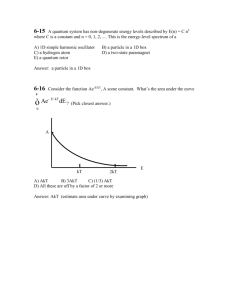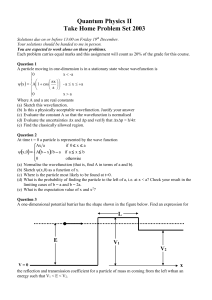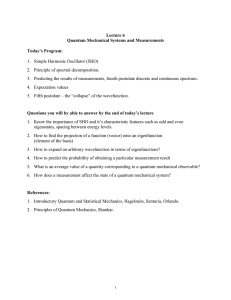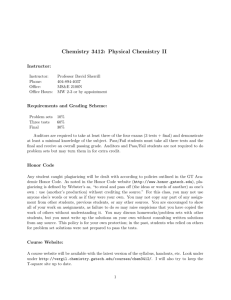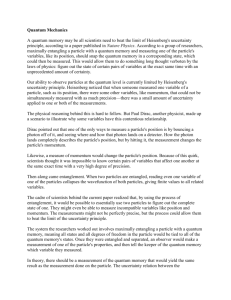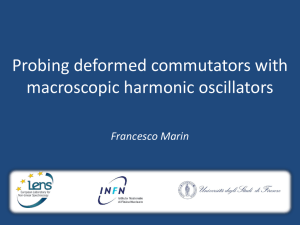CT6
advertisement
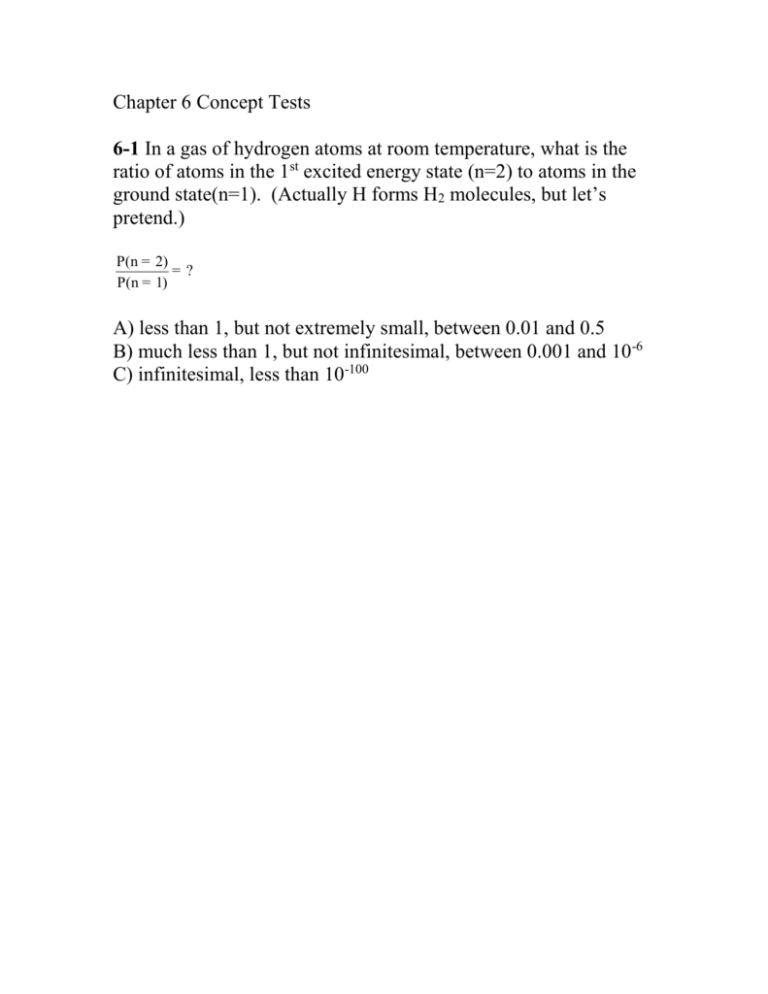
Chapter 6 Concept Tests 6-1 In a gas of hydrogen atoms at room temperature, what is the ratio of atoms in the 1st excited energy state (n=2) to atoms in the ground state(n=1). (Actually H forms H2 molecules, but let’s pretend.) P(n = 2) =? P(n = 1) A) less than 1, but not extremely small, between 0.01 and 0.5 B) much less than 1, but not infinitesimal, between 0.001 and 10-6 C) infinitesimal, less than 10-100 6-2 A quantum system has the following energy level diagram. Notice that the temperature is indicated E g(E) 6 3 kT 5 2 4 1 1 0 5 6 7 8 1 2 3 4 i=0 Which is true? A) P(i=3) > P(i=2) B) P(i=3) < P(i=2) C) P(i=3) = P(i=2) A) P(i=5) > P(i=2) B) P(i=5) < P(i=2) C) P(i=5) = P(i=2) A) P(E=1) > P(E=0) B) P(E=1) < P(E=0) C) P(E=1) = P(E=0) 6-3 A quantum system has the following energy level diagram. The ground state energy is set at zero. The first excited energy level has energy . Notice that the temperature is indicated. g(E) E 6 5 4 1 kT 5 6 7 8 1 2 3 4 9 i=0 Roughly, what is the value of Z, the partition function? A) 2.8 B) 3 C) 10 D) 20 E) impossible to tell without more information Roughly, what is the probability that the system will be found in the ground state? A) 1 B) 1/3 C) 1/10 D) 1/100 [Exact Answers: 7.6, 0.13] As the temperature is increased, the partition function will A) increase B) decrease C) remain constant 6-4 A particle (moving in 1D) has position and momentum indicated. Where is the particle in phase space? x 0 p (D) (A) (B) x (E) (C) 6-5 A 1D simple harmonic oscillator is oscillating back and forth. As the system evolves in time, its phase space points traces out which trajectory? x 0 p (A) (B) x (C) 6-6 +¥ - x2 The “gaussian integral” òe - ¥ dx is A) about 1 B) about 10 C) about 0.1 D) about 100 Answer: p ; 1.77 6-7. The distribution of particle kinetic energies in an ideal gas is given below. The rms average kinetic energy is most nearly A B 0.5 C 0.4 D ( x) 0.2 0 0 0 0 1 2 3 4 x E(units of kT) 4 6-8 The number of states in the volume of the shell shown of thickness dn and radius n is nz dn n ny nx 1 2 A) 4p n dn 8 C) something else Exam I was… A) too hard B) too easy C) about right B) 14 3 p n dn 83 6-9 What is the probability that a molecule in an ideal gas has an energy between 0 and 3kT A) about 0.1 B) about 0.5 C) about 0.99 D)None of these 0.5 0.4 D ( x) D(E) 0 0.2 0 0 1 2 0 x of kT) E(units 3 4 4 6-10 How would you compute the average speed (mean speed) of a molecule in an ideal gas? ¥ v D(v)dv A) ò 0 B) 3kT m C) Answers A and B give the same answer 6-11 This is the energy-level spectrum of a A) 1D simple harmonic oscillator B) a particle in a 1D box C) a hydrogen atom D) a two-state paramagnet E) a quantum rotor E All levels Non-degenerate 6-12 True(A) or False(B): the entropy of a system in thermal contact with a heat bath cannot decrease. 6-13 True(A) or False(B): the entropy of an isolated system cannot decrease. 6-14 A ball rolls back and forth in a valley and eventually comes to rest at the bottom of the valley. As the ball rolled to a stop, the Helmholtz free energy F = U – TS of the ball A) increased B) decreased C) remained constant D) impossible to tell without more information 6-15 A quantum system has non-degenerate energy levels described by E(n) = C n2 where C is a constant and n = 0, 1, 2, .... This is the energy-level spectrum of a A) 1D simple harmonic oscillator C) a hydrogen atom E) a quantum rotor B) a particle in a 1D box D) a two-state paramagnet 6-16 Consider the function Ae-E/kT, A some constant. What’s the ¥ area under the curve ò Ae - E / kT dE ? (Pick closest answer.) 0 A kT 2kT A) AkT B) 3AkT C) (1/3) AkT D) All these are off by a factor of 2 or more E 6-17 ¶F ¶F dF = dT + dV and dF = - S dT + - p dV Recall ¶T V ¶V T True (A) or False (B) : ¶S ¶p = ¶V T ¶T V 6-18 A quantum system has degenerate energy levels described by C E(n) = - 2 where C is a constant and n = n +1, 2, .... This is the energy-level spectrum of a A) 1D simple harmonic oscillator C) a hydrogen atom E) a quantum rotor B) a particle in a 1D box D) a two-state paramagnet 6-19 True(A) or False(B): for x, y = 0, 1, 2.. å x,y e x+ y ö æ öæ x ÷ç y÷ ç = çå e ÷ç e ÷ å ÷ ÷ ç çè x ÷ øçè y ø 6-20 As the temperature decreases, wavepackets describing particles in a gas tend to get A) larger B) smaller C) stay constant in size 6-21. A 1D SHO quantum system is in the “high-temperature” regime kT>>. What is the thermal average energy of the system? E kT 0 A) kT B) (3/2)kT C) (1/2)kT 6-22. A 1D SHO quantum system is in the “low-temperature” regime kT<<. The thermal average energy of the system is closest to : A) 0 B) kT C) E 0 kT
